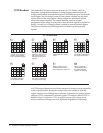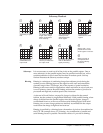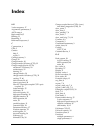
36 Advanced Camera Operation Manual
There are some special adaptations of frame-transfer devices, shown in Frame
Transfer Variations.
Frame Transfer Variations
Standard frame transfer
Image Storage
High-speed framing
Image Storage
Spectral framing
Image Storage
High-Speed Framing The frame transfer concept can be extended to multiple frames by masking most
of the parallel register and using only a small region as the image array. A scene
is focused on the image array and a high-speed shutter or strobe light is used to
time the exposure. After each exposure, charge from the image array is quickly
shifted under the mask and a new image can be acquired. Once the parallel
register is filled with images, it is read out.
Because fewer rows are clocked to shift the image array into storage, this mode
works much faster than standard frame transfer.
The high-speed framing rate need not be constant, but may be varied in
response to the needs of the observation being made. High-speed spectra of a
decaying phosphor, for example, may be obtained with decreasing time
resolution in response to the exponential decay time of the emitted light.
Spectral Framing In a mode particularly suited for spectroscopy, the CCD is masked so that only a
single row of the parallel register is exposed. In this mode, one-dimensional line
images can be acquired at a very high speed until the parallel register is filled
up.
Spectral-framing CCDs are used in time-resolved spectroscopy. An observation
could consist of hundreds of individual spectra, distributed over time. The CCD
clocks are controlled by computer, so non-linear time bases are possible.
Interline Transfer
The interline-transfer CCD has a parallel register that has been subdivided so
that the masked storage area fits between columns of exposed pixels. The
electronic image accumulates in the exposed area of the parallel register, just as
it does in the frame-transfer CCD. At readout, the entire image is shifted under
the interline mask. The masked pixels are read out in a fashion similar to the
full-frame CCD.
To enhance the interline transfer CCD's sensitivity, micro lenses are applied
directly to the CCD's surface. The micro lenses cover the entire pixel and part of
the mask on either side of the pixel. In this way, the micro lenses help to focus
light to the CCD's parallel register by funneling photons to active pixels rather
than allowing them to bounce off of the masks.


















